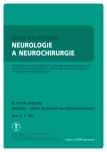Supraclavicular flap in reconstruction of intraoral defects
Authors:
P. Šín 1; A. Hokynková 1,2; J. Blahák 2,3; P. Rotschein 1; Z. Daněk 2,3
Authors place of work:
Klinika popálenin a plastické chirurgie FN Brno
1; LF MU Brno
2; Klinika ústní, čelistní a obličejové chirurgie FN Brno
3
Published in the journal:
Cesk Slov Neurol N 2018; 81(Suplementum 1): 43-46
Category:
Původní práce
doi:
https://doi.org/10.14735/amcsnn2018S43
Summary
Introduction:
A free flap transfer is considered as a method of choice in reconstruction of extensive defects in the orofacial area. However, loco-regional flaps represent a significant alternative in certain cases.
Aim:
The aim of the study was to evaluate the usefulness of supraclavicular flap in the reconstruction of extensive oral defects with focus on the surgery technique and eventual postoperative complication and prevention of chronic wounds.
Patients and methods:
Two patients with a spinocellular carcinoma of the buccal part of oral cavity (both men, 68 and 82 years) were included in our study. The reconstruction of the defect with supraclavicular flap with exactly defined vascular pedicle was done right after the resection of the tumour. The following parameters were assessed: the length of the surgery, TNM classification, histopathological type of tumour and postoperative complications.
Results:
The supraclavicular flap was fully healed in both patients with a great aesthetic and functional result with a minimal morbidity of the donor site. None postoperative complications were observed in flap healing despite the high risk of non-healing wound formation.
Conclusion:
The supraclavicular flap is a fast and effective method for closure of intraoral defects in certain patients. It is procedure which influences the quality of life of patients and effective solution in potentially severe non healing wounds.
Key words:
intraoral defects – reconstruction – supraclavicular flap
The authors declare they have no potential conflicts of interest concerning drugs, products, or services used in the study.
The Editorial Board declares that the manuscript met the ICMJE “uniform requirements” for biomedical papers.
Zdroje
1. Giordano L, Di Santo D, Occhini A et al. Supraclavicular artery island flap (SCAIF): a rising opportunity for head and neck reconstruction. Eur Arch Otorhinolaryngol 2016; 273(12): 4403–4412. doi: 10.1007/ s00405-016-4092-4.
2. Hanasono MM, Matros E, Disa JJ. Important aspects of head and neck reconstruction. Plast Reconstr Surg 2014; 134(6): 968e–980e. doi: 10.1097/ PRS.0000000000000722.
3. Giordano L, Bondi S, Toma S et al. Versatility of the supraclavicular pedicle flap in head and neck reconstruction. Acta Otorhinolaryngol Ital 2014; 34(6): 394–398.
4. Pokorná A, Benešová K, Mužík J et al. Data sources for monitoring of non-healing wounds in a national health information system – epidemiology of non-healing wounds – analysis of the national register of hospitalized patients in 2007–2015. Cesk Slov Neurol N 2017; 80/ 113 (Suppl 1): 8–17. doi: 10.14735/ amcsnn2017S8.
5. Peřina V, Blahák J, Bulik O. Karcinomy hlavy a krku – vlivy HPV infekce. LKS 2015; 25(10): 198–202.
6. Emerick KS, Herr MA, Deschler DG. Supraclavicular flap reconstruction following total laryngectomy. Laryngoscope 2014; 124(8): 1777–1782. doi: 10.1002/ lary.24530.
7. Lamberty BG. The supra-clavicular axial patterned flap. Br J Plast Surg 1979; 32(3): 207–212.
8. Atallah S, Guth A, Chabolle F et al. Supraclavicular artery island flap in head and neck reconstruction. Eur Ann Otorhinolaryngol Head Neck Dis 2015; 132(5): 291–294. doi: 10.1016/ j.anorl.2015.08.021.
9. Sandu K, Monnier P, Pasche P. Supraclavicular flap in head and neck reconstruction: experience in 50 consecutive patients. Eur Arch Otorhinolaryngol 2012; 269(4): 1261–1267. doi: 10.1007/ s00405-011-1754-0.
10. Adams AS, Wright MJ, Johnston S et al. The use of multislice CT angiography preoperative study for supraclavicular artery island flap harvesting. Ann Plast Surg 2012; 69(3): 312–315. doi: 10.1097/ SAP.0b013e31822afaba.
11. González-García JA, Chiesa-Estomba CM, Sistiaga JA et al. Utility and versatility of the supraclavicular artery island flap in head and neck reconstruction. Acta Otorrinolaringol Esp 2018; 69(1): 8–17. doi: 10.1016/ j.otorri.2017.03.004.
12. Hokynková A, Šín P, Černoch F et al. Employment of flap surgery in pressure ulcers surgical treatment. Cesk Slov Neurol N 2017; 80/ 113 (Suppl 1): S41–S44. doi: 10.14735/ amcsnn2017S41.
13. Trautman J, Gore S, Potter M et al. Supraclavicular flap repair in the free flap era. ANZ J Surg 2018; 88(6): 540–546. doi: 10.1111/ ans.14263.
14. Loghmani S, Eidy M, Mohammadzadeh M et al. The supraclavicular flap for reconstruction of post-burn mentosternal contractures. Iran Red Crescent Med J 2013; 15(4): 292–297. doi: 10.5812/ ircmj.1600.
15. Su T, Pirgousis P, Fernandes R. Versatility of supraclavicular artery island flap in head and neck reconstruction of vessel-depleted and difficult necks. J Oral Maxillofac Surg 2013; 71(3): 622–627. doi: 10.1016/ j.joms.2012. 07.005.
Štítky
Detská neurológia Neurochirurgia NeurológiaČlánok vyšiel v časopise
Česká a slovenská neurologie a neurochirurgie

2018 Číslo Suplementum 1
- Metamizol jako analgetikum první volby: kdy, pro koho, jak a proč?
- Fixní kombinace paracetamol/kodein nabízí synergické analgetické účinky
- Tramadol a paracetamol v tlumení poextrakční bolesti
- Realita liečby bolesti v paliatívnej starostlivosti v Nemecku
Najčítanejšie v tomto čísle
- Dekubity u pacientov s komorbidnými neurologickými ochoreniami
- Chondroblastický osteosarkom maxily, pacientka s Li-Fraumeni syndromem
- Monitoring tlakových lézí – validace datasetu po druhém pilotním sběru dat
- Rekonstrukce defektů dutiny ústní supraklavikulárním lalokem
